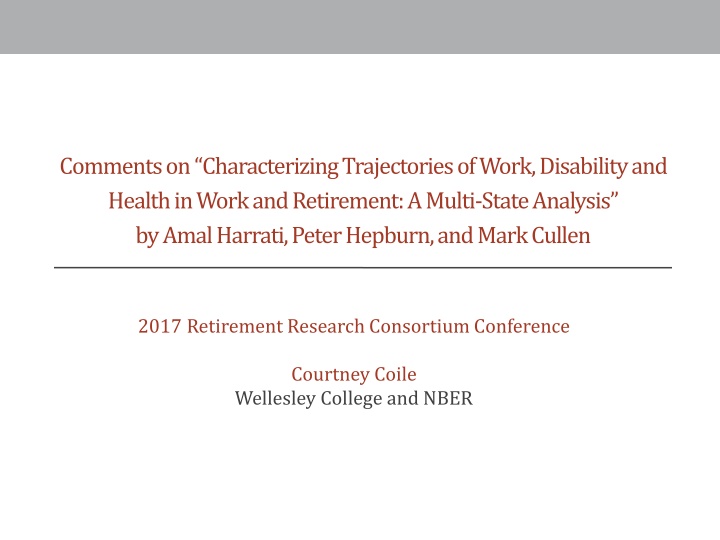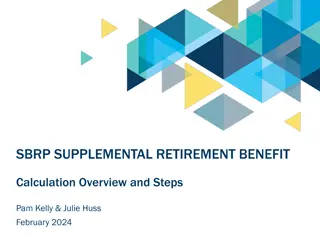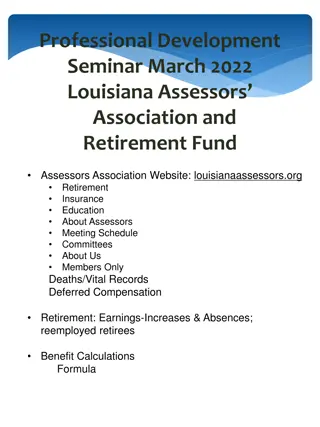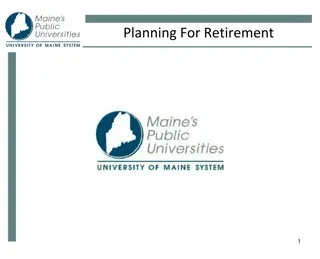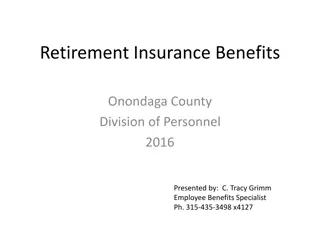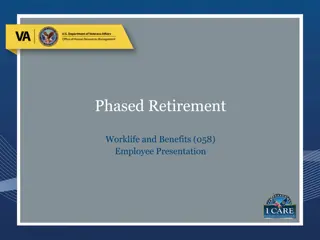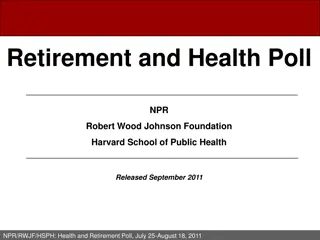Health in Work and Retirement: A Multi-
This study analyzes trajectories of work and disability using unique data from a large firm, identifying demographic and job characteristics associated with these trajectories. The research explores patterns of health, disability, and work before retirement, using longitudinal data to distinguish between types of disability events. Questions and suggestions focus on understanding short-term disability (STD), long-term disability (LTD), and the impact of employer accommodations on trajectories.
Download Presentation

Please find below an Image/Link to download the presentation.
The content on the website is provided AS IS for your information and personal use only. It may not be sold, licensed, or shared on other websites without obtaining consent from the author.If you encounter any issues during the download, it is possible that the publisher has removed the file from their server.
You are allowed to download the files provided on this website for personal or commercial use, subject to the condition that they are used lawfully. All files are the property of their respective owners.
The content on the website is provided AS IS for your information and personal use only. It may not be sold, licensed, or shared on other websites without obtaining consent from the author.
E N D
Presentation Transcript
Comments on Characterizing Trajectories of Work, Disability and Health in Work and Retirement: A Multi-State Analysis by AmalHarrati, Peter Hepburn, and Mark Cullen 2017 Retirement Research Consortium Conference Courtney Coile Wellesley College and NBER
Paper Overview Goals: 1. Use unique data on 40,000 employees of a large firm to characterize trajectories of work and disability 2. Identify demographic and job characteristics associated with trajectories to provide insight into disability processes Key early findings: 67% regular work ; 22% short STD (single STD or LOA); 11% disruptive work (multiple STD episodes) Female, hospitalizations, high health risk score DW Exposure to particulates STD and DW 1. 2.
Whats Exciting Here Looking at patterns of health, disability, and work before the exit from work Much research on effect of health on retirement or DI take- up determinants, much less on what happens before that Unique administrative data set to explore this Linked data on work status, job characteristics, and health claims for 42,000 employees for up to 17 years Researchers often use administrative data on earnings (SSA data) or health (Medicare claims data), but rarely have detailed info on both employment and health Longitudinal data allows authors to carefully distinguish between types (e.g., short STD vs. DW) and to see sequence of events (e.g., health decline then STD)
Questions/Suggestions (I) What is STD? Paid leave for a medical work absence of up to 6 months; eligible for pay on first day of absence for hospitalization/outpatient surgery/injury, after 7 days for illness This is a broad definition of disability (includes sick leave) Differentiate STD by leave length/reason to distinguish between those with a more/less severe disability What about LTD? LTD provides benefits until age 65 if totally disabled; must apply for SSDI Authors drop 700 employees who enter LTD Include LTD in classification of trajectories, explore what characteristics are associated with LTD path
Questions/Suggestions (II) Do employer accommodations affect trajectories? Policy relevance: some (e.g., Burkauser & Daly, 2011) have proposed employer experience-rating of SSDI tax Useful to think of the trajectory as potentially endogenous to availability of disability accommodations Look at how job characteristics affect whether workers with an STD episode have another or go on LTD Are there any measures of employer accommodations? (e.g., switch to part-time status or a new job)
Questions/Suggestions (III) What causal conclusions can be reached? Intro: Little research attempts to account for endogeneity between employment, health, and disability Results: Health appears to be strongly associated with work trajectories in DW typology Of course, these results imply statistical association but not directional causality Specify causal pathways of interest: health disability employment H D: Use longitudinal data to show what is happening to health before the STD (how long before STD do health changes occur? What kinds of health changes predict STD?) H D: Define health shocks (plausibly exogenous) and focus on their effects on disability and employment D E: Explore effects of STD on earnings, promotion, and early retirement disability,
Conclusion Intersections between work, disability, and health deserve more study, especially how this evolves over career and not just in year or two before retirement This paper is well-positioned to provide insights on trajectories of work and disability Urge authors to employ their unique data to its full potential and look forward to seeing the results
